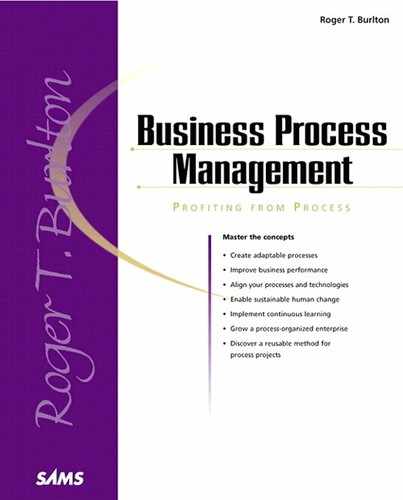Developing a Transformation Strategy
This step builds a framework for all the results to be accomplished in the Develop and Implement phases, which will be covered in Chapters 15, “Developing Capability for the Renewed Process,” and 16, “Implementing and Rolling Out the Business Solution.” In this step, the renewal champions gain management commitment to the schedule of tasks that must be accomplished and provides direction to all project teams, who must provide deliverables to overall rollout initiatives. At this point, the process owner and project manager deliver to the rest of the organization the ability to manage the remainder of the project.
Techniques
To develop a transformation strategy, the last step in the Renew phase, you need to use the following techniques:
Commitment-based project management
Negotiation
Lessons Learned
This step delivers an overall synchronized approach for development and rollout. It should result, not in a detailed plan, but in a directional document showing dependencies and timeframes. To accomplish this, identify the most appropriate sequence and phasing of solution implementation that delivers the optimum business benefits as soon as possible. Determine the staff’s capability to accommodate changes while keeping the business operating. For each enabler area—such as human resources, technology, and facilities—determine the required solutions by business rollout stage. Then develop a professional approach and a quick-cut, high-level plan. Consolidate these approaches into an overall strategy.
Structure the deliverables and dependent projects by looking at the steps in the Develop and Implement phases. Also, use the Process Management Hexagon (refer to Chapter 3, “Principles of Process Management”) to be sure that no important aspects of change are missed.
The prime driving force will be the decision regarding the major transition points toward the complete solution. These “releases” must be distinct and clear, so that each responsible manager knows exactly what has to be produced at each release point, and so that the business can accrue early beneficial results. Avoid bang solutions if at all possible.
Remember, the business must transform itself while it’s still doing business. This will stress the resources unless early savings free up the time and mind-share required for change. Emphasize the importance of the early savings first.
The overall project manager shouldn’t take on one of the building initiatives (facilities, systems, jobs and organization, HR, and so on) but should remain the overall driver and guider.
Don’t ignore people’s ability to change—it might just take more time than you think. Revolutionary ideas can be implemented in an evolutionary manner, if planned that way.
Don’t ignore constraints and agreements currently in place, such as collective bargaining agreements and long-term customer or supplier arrangements. There’s a lot to synchronize.
Be prepared for lots of stonewalling, negotiation, and changes. Be flexible and remember the overall objectives.
